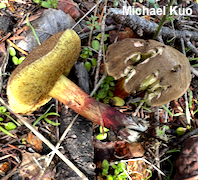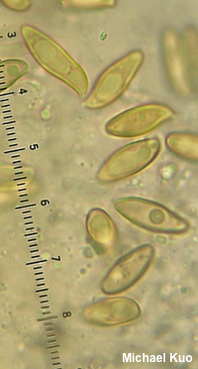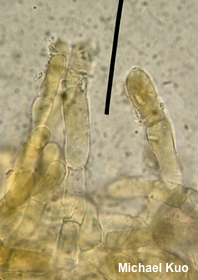| Major Groups > Boletes > Xerocomellus diffractus |

|
[ Basidiomycota > Boletales > Boletaceae > Xerocomellus . . . ] Xerocomellus diffractus by Michael Kuo, 28 March 2024 This is western North America's version of Xerocomellus chrysenteron, recognized by the brown cap that develops cracks, with pinkish flesh showing between the cracks—and by a combination of other features, including the slow and usually faint blue bruising, and the non-truncated spores. Similar brown-capped western species usually bruise blue more intensely and more quickly. They include Xerocomellus mendocinensis and Xerocomellus amylosporus, both with truncated spores (in the former the spores are inamyloid, in the latter they are amyloid); and two species with non-truncated spores, Xerocomellus salicola and Xerocomellus rainisiae (the former associated with willows, poplar, or birches, and the latter associated with conifers). Description: Ecology: Mycorrhizal, putatively with both hardwoods and conifers (I doubt this, and suspect insufficient host documentation as the explanation); growing alone, scattered, or gregariously; fall and winter; originally described from Oregon (Siegel et al. 2020); distributed from the Rocky Mountains westward. The illustrated and described collections are from California. Cap: 3–7 cm; convex, becoming broadly convex; dry; finely velvety when young, but soon bald; becoming cracked in age, with reddish to pinkish flesh showing in the cracks; brown to olive brown. Pore Surface: Yellow when young, becoming olive yellow; not bruising, or bruising slowly bluish gray to brownish; with 1–2 angular pores per mm; tubes to 5 mm deep. Stem: 3.5–7 cm long; 0.5–1 cm thick; more or less equal, or with a pinched base; solid; yellow at the apex or sometimes nearly overall; red to purplish red below; the pigment often breaking up into scaber-like dots; basal mycelium whitish to yellowish. Flesh: Whitish to yellowish in cap; yellow in stem; not staining when sliced, or staining slowly and erratically bluish. Odor and Taste: Not distinctive. Spore Print: Olive brown. Microscopic Features: Spores 10–15 x 4–6 µm; boletoid-fusiform; smooth; golden in KOH; inamyloid to brown in Melzer's. Basidia 35–38 x 5–8 µm; subclavate; 4-sterigmate. Hymenial cystidia 45–55 x 5–10 µm; fusiform to lageniform; smooth; thin-walled; hyaline in KOH. Pileipellis a collapsing palisadoderm; elements 6–15 µm wide, smooth or encrusted, septate, golden in KOH; terminal cells elongated, with apices subclavate or merely rounded. REFERENCES: N. Siegel, C. F. Schwarz & J. L. Frank, 2020. (Arora, 1986; States, 1990; Desjardin, Wood & Stevens, 2015; Evenson, 2015; Siegel & Schwarz, 2015; Frank et al., 2020.) Herb. Kuo 01142404, 01142405. This site contains no information about the edibility or toxicity of mushrooms. |
© MushroomExpert.Com |
|
Cite this page as: Kuo, M. (2024, March). Xerocomellus diffractus. Retrieved from the MushroomExpert.Com Web site: http://www.mushroomexpert.com/xerocomellus_diffractus.html |


